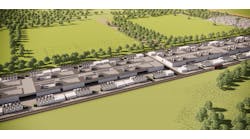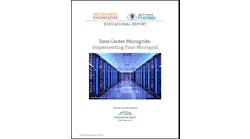It wasn’t a hurricane, blizzard or blackout that gave Todd Wilcox the idea to develop a community microgrid in North Bay, Ontario.
Instead, of all things, it was a hockey game.
The CEO of North Bay Hydro was watching a game at the local ice rink, an important gathering spot for the small city in northeastern Ontario.
He saw a young child sidle up admiringly to a sidelined player and ask for an autograph. After signing, the player put a hand on the child’s shoulder, and the two watched the the game together.
Wilcox got to thinking about community centers and their importance – and why they need to be protected. It occurred to him that the rink could be made into something more, a showcase for the future, “a place where you are proud to come.”
Now the Memorial Gardens ice rink, along with a nearby community aquatic center, are about to become centerpieces of a community microgrid under development by North Bay Hydro in partnership with S&C Electric Canada.
Called the North Bay Community Energy Park, the campus will include 100 kW of solar, 250 kW/250 kWh of energy storage, a 600-kW combined heat and power plant (aka CHP or cogeneration) and electric vehicle charging stations. S&C’s GridMaster microgrid controller will act as the brains of the system, integrating the components.
The solar panels will be on top of the aquatic center. And unlike most solar panels, they will have the ability to operate in islanded mode, meaning they can separate from the central power grid when it experiences an outage.
Via the microgrid controller, the solar energy will supply power to the neighboring ice rink. The solar panels also will contribute energy for the electric vehicle charging stations. The CHP plant will power the community microgrid and use waste heat produced in the process for the aquatic center and ice rink.
Community microgrid as a shelter
With the microgrid in place, the ice rink and aquatic center will continue to have electricity during storms or other disasters, so the facilities can serve as shelters, a “priceless community benefit,” Wilcox said, as evidenced in Houston during Hurricane Harvey.
[clickToTweet tweet=”How a Kid and a Hockey Game Created a Community #Microgrid” quote=”How a Kid and a Hockey Game Created a Community Microgrid”]
“There is not a lot of infrastructure here that has back-up power. With the microgrid, cogeneration, solar and battery we can operate if the grid is not available. We can island. So there is a real community resiliency aspect to the project. That was another motivation to do this,” he said.
The microgrid also creates a water-saving benefit for the aquatic center. If there is a grid outage, and the pump for the pool stops working, even for only a few hours, the pool must be drained and refilled. The microgrid will keep the power flowing, and pump operating, so that the water does not have to be replaced.
The new energy equipment will be housed in a visible location, so that it can act as an education piece for the community. “This is all about customer engagement; we think that is really important.”
Work has begun on the project, with heating connections installed at the rink. Next comes the connections for the pool. And this fall electrical ducts and district heating pipe will be put in place. The bulk of the project, the CHP, solar and battery energy storage will be installed in the spring. The project is scheduled to be in service in September 2018.
The project will be owned and operated by North Bay Hydro Services, which is an unregulated affiliate of municipal utility North Bay Hydro. The regulated utility will provide technical support.
Wilcox described the microgrid as a behind-the-meter commercial project, not funded by taxpayers. Financing details have yet to be announced.
Not for the faint of heart
North Bay Hydro is experienced installing and operating energy infrastructure, but a microgrid can be particularly complex to operate. “These are type of projects are not for the faint of heart,” he said.
That’s one of the reasons North Bay Hydro brought in S&C Electric as a partner.
“I’ve been around the industry almost 40 years, and S&C has really impressed me in terms of their technical capability. We can do the cogen part on our own, no problem. We can do the solar. But the battery and microgrid controller, no, no way. The inverter and scenarios around how to optimize the microgrid? We need their help to do that.”
Still there are challenges ahead for the project. A big one is Ontario’s wide climate swings, which will test the strength and flexibility of the project equipment. Temperatures vary from 40 degrees below zero in winter to average summer highs in the mid-70s.
“We’re really curious to see how the technology holds up through these extremes,” Wilcox said. “This is a real learning opportunity. If we can do it here, in North Bay, it will certainly be replicable in a lot of different jurisdictions.”
So the kid, the hockey game, and idea they inspired may reach well beyond North Bay.
Read about other microgrids like this one on the Microgrid Knowledge community microgrid channel.






